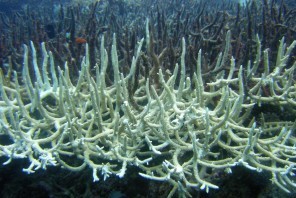How white band disease sweeps through a reef

“Living in panama and working on the reefs I would watch white band disease sweep through the population,” said assistant professor of earth and environmental science Steve Vollmer. He pursued post-doctoral research at the Smithsonian Tropical Research Institute on Barro Colorado Islan.
The disease he’s talking about is one of 22 that affect coral reefs. All of these have cropped up in the last three decades and many seem to be linked of rising ocean temperatures and development, said Vollmer. WBD in particular “is identified by a progressing band of dying white tissue.”
When he started asking what was known about the disease, he found the answer to be “not much.” Vollmer has since dedicated his research to its study and in the last few years has made significant progress.
“The pathogen is still unknown, although we have a good idea,” he said. One of the first and most important experiments Vollmer’s lab carried out was to determine whether the white band pathogen was a bacteria or a virus. They did this by separating what they call “the slurry of pestilence and disease”—a solution of diseased tissue—into two fractions. One contained only bacteria while the other contained viruses and small microbes. When they tried to inoculate healthy corals with the two fractions, only the bacterial fraction caused the disease. While a specific pathogen has yet to be pinpointed, Vibrio and Rickettsiales bacteria are potential culprits.
In a paper recently released in the journal Scientific Reports, Vollmer and his team, including grad students Sarah Gignoux-Wolfsohn and Chris Marks, explored the transmission mechanisms of the pathogen—regardless of its identity.
First they looked at two different snail species (Coralliophila abbreviata and C. caribaea) that are fond of nibbling on the a coral type affected by WBD: Acropora cervicornis, also known as staghorn coral. For two weeks prior to the experiment, they limited the snails’ diets to only healthy corals or only sick corals…or they starved them altogether. Then they let the snails go to it with healthy corals.
The C. abbreviata species managed to infect the healthy coral regardless of what they’d been eating for the last two weeks—even snails that only ate healthy coral caused WBD in the experimental individuals. This suggested to the team that C.abbreviata also acts as a reservoir for the pathogen, carrying it around for weeks at a time without betraying any of its own symptoms. C. caribaea on the other hand never transmitted WBD to healthy corals. The team suspects there are two possibilities for this discrepancy: either C. caribaea just didn’t eat enough coral to transmit the disease (they apparently have smaller apetites than their abbreviata buddies) or they are for some reason inhospitable to the pathogen.
In a second experiment, Vollmer’s team looked at the pathogen’s ability to travel through the water column to infect distant individuals. They added diseased coral bits to a closed-circuit aquarium that either contained healthy intact coral, or injured coral. Transmission occurred in the case of the latter, but not the former, suggesting that water only acts as a transmission vector when it comes to injured coral.
This work could have meaningful impacts on how the disease is managed and controlled. Corals are foundational species for marine environments, said Vollmer. “Reefs are essential habitat for fish and economies depend on them for tourism.” As water temperatures continue to rise and as human development continues to creep across the globe, understanding disease mechanisms is critical.
